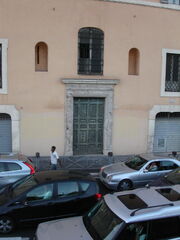Santa Maria del Buon Viaggio is an 18th century former confraternity church which is part of the complex of the Ripa Grande, and is at Via del Porto di Ripa Grande 8 in Trastevere. It is near the Ponte Sublicio, and should not be confused with San Michele a Ripa which is in the same enormous complex but to the north-east.
The dedication is to the Blessed Virgin Mary, under her title of "Our Lady of a Good Voyage".
History
Maria della Torre
The present church is on or near the site of the mediaeval church of Santa Maria della Torre, named after a 9th century defensive tower which had been converted into its campanile. The tower had been built by Pope Leo IV (847-55) as a protection against marauders (including Muslim ones) sailing up the river, and was part of the same scheme as the walls enclosing the Leonine City.
The first documentary mention of the church is in a papal bull of 1217, where it is referred to as a chapel. This indicates that it had no parochial responsibilities.
This little church was given into the care of the Fathers of Christian Doctrine in 1578.
San Michele
However, the old church was demolished at the end of the 17th century to make way for an extension of the Ospizio di San Michele.
This orphanage had been founded in 1686, but in 1693 Pope Innocent XII commissioned the architect Carlo Fontana to renovate and extend it. The result was the enormous building now standing.
A new church was incorporated into its fabric at the west end, renamed “Our Lady of the Good Voyage” since it was the guild church of the sailors who worked the river traffic to the Ripa Grande, which was then the main quay in the city. It had the right to a toll from every boat using the quay.
The church itself was begun in 1710, and completed four years later with the assistance of Giacomo Onorati Recalcati.
Modern times
This church has had an obscure existence since then.
In 1941 it was granted to the Padri della Piccola Missione, who had a mission for deaf and dumb people here for some years.
The orphanage complex was closed down in stages starting in the late 19th century, and for most of the 20th century the buildings were to a greater or lesser extent disused or employed for transient purposes. Serious renovation has been taking place in the 21st century, under the aegis of the Ministero per i Beni e le Attività Culturale, and the complex is now a location for exhibitions and cultural activities.
However, this church has been disused (although not deconsecrated) for an extended period, and its future as a place of worship is in doubt.
The devotion to the Madonna del Buon Viaggio is popular in Palermo in Sicily, and also occurs elsewhere in Italy such as at Montepulciano. Apparently it is kept up at the nearby church of Santa Maria dell'Orto.
Exterior
Layout
The little church is tucked into the southern corner of the south-westernmost court of the Ripa Grande complex, and is on a simple square plan. It is invisible from the street.
The plan is a straightforward rectangle, with a rectangular apse entered through a triumphal arch and two side altars in very shallow niches. The main body of the church is part of the enormous Ospizio building, but the apse protrudes into a courtyard to the north and has a pitched and hipped roof.

Façade
The church's presence is only apparent from the outside by means of the entrance, which has bronze doors in a plain marble doorcase. Above this is a dedicatory inscription, reading:
D[eo] O[ptimo] M[aximo], templum Domini est. Dominus est rex gloriae. Deus Sabaoth. Turris Davidica. Apostolicae S[ancti] Sedis ecclaesia. Dei mater S[anctissima] Virgo Maria de Turri Stella Maris.
This refers to the old dedication, and reads: "To God, the greatest and mightiest. It is the temple of the Lord. The Lord is the king of glory. God of armies. Tower of David. A church of the holy apostolic see. Holy Virgin Mary, mother of God of the tower, Star of the Sea". The inscription is protected by a projecting flat cornice.
There is a large window with a shallowly curved top above the entrance, and flanking this is a pair of round-headed niches. The church does not have a campanile, and each of these niches used to hold a bell.
Interior
The three altars have anonymous altarpieces of the 18th century.
Apparently there is a small external chapel on the left hand side, which contains a decayed wall-painting dating from the early 18th century when the church was built.
Access
There have been exhibitions held here, but apparently not recently. The last seems to have been in 2000.
Otherwise, the church seems to be permanently closed and is a candidate for the most obscure historic church in the Centro Storico. No online photo of the interior seems to exist.